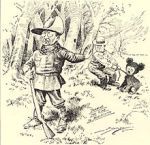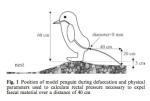Martin Fone's Blog, page 321
August 19, 2016
Tales From The Nursery – Part Forty Two
Round and round the garden
This rhyme is ostensibly very simple and nowadays takes the form, “round and round the garden/ went a teddy bear/ one step, two step/ tickle you under there”. The rhyme is accompanied by some actions which involve taking the baby or toddler’s palm and walk on it with in circles with your middle and index fingers. When you get to the phrase “one step”, you move to the inside of the infant’s wrist and at “two steps” on to the inside of the elbow. The final line is accompanied by the adult tickling junior under the armpit. It never fails to amuse them, I’m told.
The clue to dating the rhyme would seem to be the reference to a teddy bear, the cuddly toys that are popular with the little ones. Teddy bears are a relatively recent phenomenon. In November 1902 the US President, Theodore Roosevelt, known as Teddy, was invited to go on a bear hunting trip in Mississippi. Roosevelt’s party cornered, clubbed and tied an American Black Bear to tree after having chased it with a pack of hounds. In deference to his position Roosevelt was offered the opportunity to shoot the poor creature but he declined, stating that it would be unsporting. However, he did suggest the bear be killed to put it out of its misery.
The incident spawned a cartoon by Clifford Berryman published in the Washington Post on November 16th 1902 which in turn prompted Morris Michtom to develop a stuffed toy bear which he sent to the President. Roosevelt allowed Michtom to use his name and so he went into production, putting his bear creation in his shop window with a sign round its neck saying Teddy’s bear. Sales were so good that in 1907 he formed the Ideal Novelty and Toy Company.
Coincidentally, at around the same time the Steiff firm in Germany had produced a stuffed bear, although it is unlikely, at least at first, that either manufacturer knew what the other was up to. Early teddy bears were made to look like real bears whereas the modern versions have larger eyes and foreheads and smaller noses to make them more friendly and winsome.
So a 20th century origin seems a slam dunk, particularly as it did not appear in print until the late 1940s. But.. and there is a big but. There are at least two other variants. One features a hare: “round about there/ sat a little hare/ the bow-wows came and chased him/ right up there”. And in Ireland we find a slight variant, “round and round the racecourse/ catch a little hare/ one step, two steps/ thickly under there!”
Although these cannot be dated with any precision, it seems to me unquestionable that they are variations on the same theme and that while the popular teddy bear version cannot be other than a 20th century version, there is no reason to believe that the basic rhyme format is of older vintage. After all, tickling, playing with and trying to amuse a baby has been part and parcel of parenthood since the year dot.
Filed under: Culture, History Tagged: Clifford Berryman, Morris Mitchom, origin of round and round the garden rhyme, origin of teddy bear, Theodore Roosevelt








August 18, 2016
Gin o’Clock – Part Ten
While I have been busily exploring the ginaissance I have been rattling off various botanicals to be found in the gins I have tried and reviewed without paying much attention to what each of these components actually are and what they might bring from a taste perspective to the drink. I have duly chastised myself and will start from this post to give a brief pen picture of some of plants you are most likely to find making a contribution to a gin.
Naturally, the starting point must be juniper or to give it its Latin and botanical tag, Juniperus communis. What may surprise you is that the juniper is a conifer and that the all-important bluish-purple berries, which take between 18 and 36 months to mature, are cones. When dried they become purplish-black in complexion. Junipers are dioecious which means that there are male plants and female ones and for pollination to take place, the pollen from the male has to make its way to the female, usually courtesy of the wind. The berries have a slightly piney flavour (natch) with hints of fruitiness and pepper.
Coriander (coriandrum sativum) is closely related to vegetables such as carrots, fennel and parsnips and is an annual plant. It grows to about two feet in height and has distinctive flat, green leaves and white flowers in bunches which look like upside down umbrellas. It is the seeds that the gin distiller is after which have a floral aroma. Coriander’s involvement in the making of gin is deep-rooted – it has been used in Gordon’s since 1769 and Tanqueray since 1830 – and it is estimated some 9 out of 10 gins deploy it.
Another favourite ingredient amongst gin distillers is angelica or to give it its delightful botanical tag, angelica archangelica, which like coriander is related to the carrot. As a plant it grows to up to 7 feet in height and has broad leaves which branch out around 3 feet and a profusion of flowers, yellow, white or green, which cascade up from a single stem like fireworks. But it is the roots that the distiller is after and tricky things they are too. They are harvested and dried but the taste profile – it has a bitter, earthy flavour – changes depending upon whether the roots are whole or crushed or powdered and it dissipates as the root ages. Probably over two-thirds of gins use angelica.
The orris root comes from any plant of the species iris germanica or the iris to you and me. I have a load growing in the garden. What is important about the orris, chemically, is that it acts as a fixative which means that it stabilises more volatile aromatics. It takes about five years to dry the root – so I am not sitting on an immediately realisable gold mine – and the roots are ground before use to extract the all-important oil. It has a woody raspberry or violet aroma but generally lurks in the background of a gin, helping to bind the other botanicals in use. Although it often takes a backseat, gins without orris tend to lose their aromas more quickly than those which have it.
Because I have stocked up on some old favourites and am still working my way through some of my more recent additions to my collection of gins, I have no new gin to review this time. This will be rectified next time but I will also continue my tour of some of the key botanicals which distillers use.
Cheers!
Filed under: Gin, Science Tagged: angelica, coriander seeds, fungus attacks British juniper bushes, ginaissance, Gordon's Gin, importance of orris in gin, juniper, juniper berries, orris root, Tanqueray gin








August 17, 2016
Book Corner – August 2016 (2)
The Essex Serpent – Sarah Perry
Don’t judge a book by its cover, they say, but you would be wrong to pass this book by because of its sumptuous William Blake style cover. What is contained within the dust jacket is a wonderful novel. Perry’s second, exploring the clash between science, religion and superstition in late 19th century England. It is not too fanciful to think each of these competing points of view are represented by serpents – the one that coils itself around Asclepius’ staff, the one in the Garden of Eden and the Essex serpent.
Reports of a flying serpent with a forked tongue and wings circulated from the Essex coast in 1669 and a pamphlet entitled Strange news out of Essex described the beast and the consternation it caused amongst the denizens of the county. Perry uses the headings of the pamphlet as the titles to the four parts of the book. The plot centres around an earthquake which hits the Essex coastline around the imaginary village of Aldwinter releasing the mythical beast to the consternation of the peccatogenetically inclined locals. The vicar, William Ransome, tries his best to calm their fevered imaginations, even resorting to removing the carving of the serpent from one of the church pews.
Cora Seabourne, a widow from an abusive marriage and with aspirations to be the new Mary Anning, arrives in the village hoping to make her name by unearthing the beast as a relic from the Jurassic age. Having had a dalliance with a surgeon, Luke Garrett, who performed cutting edge surgery until his career was tragically cut short, Cora has a love-hate relationship with Ransome. Their relationship explores the dichotomy of the definitions of the verb, cleave – to separate from or adhere to. Meanwhile the vicar’s tubercular wife comes under the spell of the serpent and draws Cora’s strange son, Francis, into her web.
Mixed in with all this we have pioneering surgery, social reform and the fears and superstitions of the working class. For a relatively modestly sized book – it runs to 440 pages – it has a broad sweep and wide range of characters. But it doesn’t feel rushed in its telling or skimpy in its characterisations, although I for one found it difficult to sympathise with any of the protagonists. The book is the product of meticulous research but it wears it lightly and the mix of pastoral – Perry is particularly good at describing the subtle changes in the countryside as the seasons progress – and gothic generates a unique atmosphere.
Perry’s style is elegant and evocative, beautiful and delicate and for the most part the novel is well-paced and, for sure, is a page turner. Once hooked, you don’t want to put it down and there is an intense sense of disappointment when you realise you have reached the end. The mix of narrative and letters moves the story along and I will not spoil the denouement.
This is a stunning book that is more than a gothic thriller. It explores the impact on moral and religious certainties that a more assertive and pioneering scientific community had and the role, rise and social acceptance of a more independent woman. The hints of modernity do not devalue the Victorian atmosphere but rather enhance the feeling of the timelessness of many of the emotions that are involved in this intriguing tale.
A truly marvellous book.
Filed under: Books, Culture Tagged: Aldwinter, Cora Seabourne, Mary Anning, meanings of cleave, Sarah Perry, the Essex Serpent, the staff of Asclepius








August 16, 2016
Motivated By Curiosity And A Desire For The Truth – Part Nineteen
Penguins are fascinating creatures, waddling on ice floes until they get into the environment they seem more at home in, the sea. When they are incubating their eggs, they are reluctant to move from the spot for fear of exposing them to predators and to prevent a drop in the temperature necessary for the hatching process. Given this predisposition, you would think that when they get a call of nature, they would foul their nest to such an extent that it would turn in to a terrible mess. But not a bit of it.
Some penguins particularly the Adelie penguin, have developed a technique whereby through the use of gastrointestinal pressures they are able to propel their faeces sufficiently far enough away from the nest to maintain a clean and tidy environment for their brood to hatch in. For the enquiring mind, the obvious question is how much pressure do they deploy. Fortunately, a pair of scientists, Victor Benno Meyer-Rochow and Jozsef Gal, published a paper in the ever popular Polar Biology in 2003 entitled “Pressures produced when penguins poo – calculations on avian defecation” which reveals all.
The starting point in their examination of the problem was empirical observation. They noted that when a brooding penguin felt the urge to go, they would go to the edge of their nest with their rear facing the outside world, lift their tail and fire. So how to measure the pressures involved, particularly as penguins are protected species? The answer was to identify the key parameters required to make a calculation, namely the distance the faecal matter travels before it hits the ground, the density and viscosity of the material discharged and, finally, the shape, aperture and height above the ground of the penguin’s backside.
Travelling to Antarctica – hey, there is no point wrestling with these problems if you can’t get a field trip out of it – the two scientists carried out some field experiments. They noted that the expelled material hit the ground approximately 40 centimetres (with a standard deviation of plus or minus 12) away from the nest, leaving behind a whitish (if they had eaten fish) or pink (if their diet had been krill based) trail which ended a few centimetres from the nest’s periphery and which could be up to a centimetre wide. They also estimated that the penguin’s orifice had a maximum diameter of 8 millimetres at the point of firing and that its rear was 20 centimetres (plus or minus 6) above the ground.
The measurement of the viscosity of the material proved more challenging as results were inconsistent. However, they settled on a viscosity the equivalent of olive oil, a decision which provided them with all the parameters required to use the Hagan-Poiseuille equation for dynamic pressure – I’m sure you are familiar with it. The results revealed a pressure reading of between 10 and 60kPa, the process commencing with the higher pressure.
It is always useful, I find, in matters like this to have a comparative. When pressures on the rectal muscles in an upright human reach 55 mmHg, the external and internal sphincter relax and the contents of the rectum are expelled. During straining, pressures may rise to 100 mmHg. But these are paltry compared with the forces that the penguins muster.
The question of how a penguin chooses which direction to face when defecating wasn’t covered in the paper. That, of course, would require another field trip!
Filed under: Science Tagged: Adelie penguin, Hagan-Poiseuille equation for dynamic pressure, Jozsef Gal, Polar Biology, pressures produced by defecating penguin compared with humans, Pressures produced when penguins poo, Victor Benno Meyer-Rochow








August 15, 2016
I Predict A Riot – Part Twelve
Heulga de la Carne (1905)
One of the unusual aspects of the Chilean Meat riots of October 1905 was that they were a slow burner – a case of well-done rather than rare – in that the casus seditionis dated back to 1897 and the introduction of a tariff on cattle crossing the Andes from Argentina. The tariff provoked immediate opposition and there were sporadic protests in 1902.
Strangely, the renewal of opposition to the tariff in 1905 was only indirectly associated with the cost of meat. In fact they were fairly stable between 1902 and 1905. What had risen in the interim was the price of staple foods such as wheat, beans and potatoes. This meant that families on lower incomes were forced to reduce their consumption of meat to maintain their level of consumption of staple foodstuffs. Generally, though, the Chilean economy expanded in the run up to 1905 as a result of increases in mineral exports and employment levels rose. Hardly the ingredients needed for a riot, you would think.
Agitation began on 1st September 1905 when the mutual aid society of Santiago meat vendors, concerned about the fall in meat sales, called a meeting to discuss the abolition of the tariff. A committee was formed and a demonstration was planned for Sunday 22nd October. A large crowd, estimates vary from between 12,000 and 50,000, assembled on the Alameda and a group carrying banners portraying a skeleton to represent the common people, a fat man smoking a cigar to represent the landlords and a fat ox labelled “meat for the rich” and a skeletal horse “meat for the common people” made their way to the Government House.
The intention was to hand a petition over to the President but the demonstrators were told that he was not there but had retired to his private residence a few streets away. A smaller group made their way there and were able to hand in their petition but the President insisted on receiving them behind closed blinds. This gave the impression to many in the street that the president had refused to accept the document.
At this point things turned ugly. Some demonstrators stoned the Government House and destroyed statues and public monuments on the Alameda and then proceeded to damage telegraph and telephone lines, burn street cars and attack and stone some private residences. Many of the rioters looted stores, in particular targeting a pharmacy which, allegedly, had refused to proffer first aid to an injured demonstrator.
The police in turn attacked the crowd but soon lost control. Some police in plain clothes went around shooting protesters without warning and this only served to fuel the mobs and spread the violence throughout Santiago. The greatest part of the violence occurred during the Sunday and Monday of what became known as Red Week which is when the majority of the buildings and half of the deaths were recorded. It was only on the Friday that the city returned to a state of clam. By that time some 70, according to Government figures, had been killed but cemetery officials reported burials of over 300 killed in the riots, in either case a significant number for a country unused to political violence.
And what of the cattle tariff? There was no immediate removal of the tariff – in fact it remained in place until 1909 when it was suspended for a couple of years but then reintroduced in 1911 until 1918 when it was abolished.
Filed under: Culture, History Tagged: Alameda in Santiago, cause of Chilean meat riot, Chilean meat riots of 1905, Chilean meat tariff, heulga de la carne, Red Week October 1905








August 14, 2016
ATM Of The Week
It’s not happened to me (yet) but imagine you are in a pub, having a few sherbets and then discover you haven’t enough dosh to settle the bill. What to do?
A male toper in the Czech town of Prerov came up with a novel solution to the question of providing collateral. He stripped off leaving his clothes in the pub and marched off, I learned this week, wearing only ankle-length black socks and talking into a mobile phone – that begs a question – in search of a cash dispenser. Inevitably he was spotted on CCTV, had his neck felt by the local constabulary but was allowed to complete his quest, settle his bill and recover his clothes.
It was a good job he was not in Whangerei, the northernmost city of New Zealand. As part of an arts project called Moodbank, an ATM has been installed which doesn’t dispense cash but allows via a touch screen offering more than 1,000 options the user to describe their current state of mind. The results, according to the genius whose idea this is, Vanessa Crowe, are then uploaded on to the project’s website to give an impression of the city’s emotional condition.
You could imagine our Czech friend’s emotion if he found that ATM.
Filed under: Humour, News Tagged: ATM collects emotion data, man leaves clothes as collateral for bar bill, Moodbank, Prerov, Vanessa Crowe, Whangerei








August 13, 2016
Trends Of The Week
I’m always on the look-out for trends which are engaging the yoof of today and here is one to bring to your attention. Beards from below will delight pogonophiles and fill pogonophobes with disgust. For those of us with beards it is quite simple – it involves putting your head right back and taking a selfie of your neck and that part of your beard between neck and chin. For added excitement you could draw two eyes, a nose and a mouth on the neck below your beard line.
There is a site (natch) where you can post your photo – #beardsfrombelow – and the images are quite startling. Perhaps Beaker from the Muppets will make a comeback.
In the interests of sexual equality, here’s one for the ladies, although I can’t help thinking that it is more designed for men to ogle at. You must have seen those cheesy pictures of male anglers proudly showing off their latest catch. #fishbras specialises in pictures of female anglers showing off their latest catch whilst holding it against their chest, disrobed or otherwise.
It takes all sorts.
Filed under: Humour, News Tagged: #beardsfrombelow, #fishbras, beard selfies, Pogonophilia, pogonophobia








August 12, 2016
What Is The Origin Of (94)?…
Upside down
Four years ago today I wrote my first post for this blog because I found it increasingly more difficult to make sense of things in this strange old world of ours. The natural order of things often seems inverted. In fact, I often find myself muttering that something is upside-down – what should be top is now at the bottom.
It seems that this sense of the world being out of kilter has been with man for many centuries. In print it first surfaces in the Pricke of Conscience, published around 1340 by the mystic and hermit, Richard Rolle, “tharfor it es right and resoune/ that thy be turned up-swa-doune”. Another 14th century poem, a translation of the Seven Sages of Rome, contains the couplet, “the cradle and the child thai found up so down on the floor”. These early sightings of our phrase have a couple of interesting features – firstly, the phrase is used as an adverb and, secondly, the sense in which so was is used can only be to mean “as if” – a peculiar usage, sniffs the Oxford English Dictionary (OED).
One of the beauties of the English language is its dynamism and within a century “so” in this context merged to form the compound “upse” which in turn created upset and “upsa”. Rather like one of those puzzles where you make one word into another but by only altering one letter at a time, during the 15th and 16th centuries upside-down could be found in a number of guises such as opsadoun, upsedoun, up set dune, upset downe, upsydowne and vpsyde downe before settling down to the familiar upside down in the 17th century.
Nowadays we use upside down as an adverb as our medieaval forefathers did but also as an adjective. The usage as an adjective, denoted at least in print with a hyphen between the two words, is a relatively new development, dating to the mid 19th century. And for those who like neologisms or, as those of us studied hard to increase our ancient Greek vocabulary, the dreaded hapax legomenon – only one citation – there is the noun upside-downism. It appears in Frederick Metcalfe’s The Oxonian in Iceland of 1861, “..and been hurled by the Demons of Misrule and Upside-Downism into a disjointed maze of confusion”.
Whilst upside down describes a static state the phrase topsy-turvy conveys a sense of motion and dynamism. Things are in a state of flux which may, indeed, result in the natural order being inverted. The phrase appeared in print in the 16th century – Richard Eden in the Decades of the Newe Worlde of 1555 wrote, “they say that..they see the houses turne topsy turuye and men to walke theyr heeles vpwarde” – but the OED suggests that it was used in popular speech earlier than that.
Topsy probably owes its origin to top and its plural tops. Turvy is much more problematic. It may come from the Old English, tearflian, which meant to roll over or to overturn. The etymological pursuit is not helped by the number of variants that appear in the early citations – tervy, tirvy, turvy and turvie. There are some 31 variations in total. One theory is that it relates to turf with the idea that someone has fallen and their head – the top – is now on the turf. This is an appealing thought but there is no evidence that it is correct. It was used as an adjective from the 1610s.
Filed under: Culture, History Tagged: hapax legomenon, origin of topsy turvy, origin of upside down, Richard Rolle, Seven Sages of Rome, upside-downism








August 11, 2016
Double Your Money – Part Six
George Hudson (1800 – 1871) and the Railway Mania
The railways, without doubt, transformed the economic fortunes of our country in the 19th century. The nascent railway industry provided the perfect opportunity for the unscrupulous to make hay. Although a Private Members’ bill was required to pass through parliament to authorise any new railway company as a measure to prevent fraud and the presentation of unviable proposals, this did not prevent the “entrepreneurs” spending all their investors’ money before the bill reached parliament – as happened with the West End and Southern Counties railway, the Bristol and Liverpool line and the Northampton, Bedford and Cambridge line.
If a bill made it to parliament there were significant conflicts of interest at play. Many MPs were significant investors in the proposed schemes and so would naturally vote them through. Other MPs were paid in guineas – the origin of the phrase guinea pig – by scheme proponents to lend their support to the cause. Newspapers puffed the advantages of a railway line and the development of a modern stock exchange made it easy for members of the public to invest. Often shares could be purchased for as little as a 10% deposit with the railway company retaining the right to call the balance at any time. Many small investors, lured by the promise of significant dividends to be earned from fool-proof schemes, sunk their savings into buying railway shares, even those who could barely afford the deposit.
The problems came when the train wheels met the tracks – it soon became apparent that many of the railways were not as easy to construct as their proponents had claimed and even when operational, the profits to be had were not as great as were originally anticipated. In late 1845 the Bank of England increased interest rates which led to share prices in railways levelling out and then plummeting. Investment stopped almost overnight leaving companies without funding and investors without the prospect of any return on their investments.
Some of the larger railway companies, the Great Western and Hudson’s Midland, bought up some of the failing lines for a fraction of their value, offering shareholders a below par value for their shares. Even so, many middle class families had lost everything when the bubble burst.
Hudson’s modus operandi was to cut costs, often at the expense of safety, offer significant dividends to investors and to cook the books. A pamphlet called “The bubble of the age” published in 1848 accused Hudson of paying dividends out of capital rather than revenue. Whether this was actually true or not, the finances of Hudson’s companies were built on sand. He had borrowed £400,000 at a high interest rate which had to be paid back in 1849. The vultures were beginning to circle and his shareholders were furious.
It soon emerged that Hudson had been selling shares between his companies at exorbitant values – when rumbled he had to pay back £30,000 – and had used the monies of the York and North Midland railway (YNMR) to build a private station at Londesborough Park, his gaff. Faced with demands to repay £750,000 Hudson sold his home (and station?) and repaid £200,000. In 1852 the YNMR magnanimously agreed to release Hudson from all his remaining liabilities for £50,000.
Foolishly, Hudson rejected the offer and the matter went to court, where he promptly lost and in the winter of 1853 had to negotiate a settlement of £72,670 to clear his debts and was forced to sell his property at Newby Park. Small consolation, perhaps, for the many who had bought a ticket to nowhere.
Filed under: Culture, History Tagged: causes of railway mania, causes of railway mania bubble to burst, George Hudson, origin of guinea pigs, railway mania, the bubble of the age, the railway king, York and North Midland railway








August 10, 2016
A New Day Yesterday – Part Nineteen
Cast your mind back. You had just got back to school after the summer holidays and you were set a task by an unimaginative school teacher, of whom there were a lot – to write about what you did on your holidays, an exercise which often had to be repeated not only in English but in whatever foreign language you happened to be studying.
Not that we thought about it in those terms at the time, but it was a very socially divisive exercise. For those whose parents were wealthy or imaginative, the terms were often mutually exclusive, there was often an embarrassment of riches from which to choose. However, for others, there was a pretty short essay to write – not much.
My mind wandered in this direction shortly after I had been asked what I had been doing in my months of retirement. Regrettably, because of a serious illness to a family member TOWT and I have been shuttling back and forth to a hospital, initially, and then a care home, leaving little time to do anything else other than maintaining the bare essentials of our own life. So not much is a pretty accurate if rather sad statement of fact.
One of things I have been thinking about is how to monetise – awful word – this blog. I find I am at my most productive in the first couple of hours of the day and I spend them thinking, researching and writing or, as TOWT puts it, locked away in my office. A thought was to open up the blog to advertising but I for one get irritated by on-line ads. There seems something slightly desperate about the way on-line advertising works. I made an innocent enquiry as to the value of a rather splendid Paddington Bear which we won in a raffle. Since then I have been pursued relentlessly by ads offering me bears at knock-down prices and I can’t shake them off.
No, I want the blog experience to be as advert-free as possible and, anyway, I can’t imagine the amount of traffic I get would be of the slightest interest to advertisers, desperate or otherwise, and certainly wouldn’t translate into oodles of money. And then the idea came to me. I would think about putting a book together from the contents of some of the posts on my blog.
I settled on the theme, selected the entries, edited them into a more cohesive whole and sent the opus to a couple of publishers. Both were encouraging, one more so than the other, and so I selected them. Contracts were signed, monies paid and the manuscript together with a completed writer’s questionnaire sent off. The manuscript is now going through a proof reading and editing process – just as well as I am the world’s worst Prof Reeedor – and a cover is being designed for me.
I’m really quite excited and can’t quite wait to receive the edited copy for my approval and to see the cover design. I gave them a couple of ideas and will be interested to see what they make of them. Fifty Clever Bastards, for that is the working title, will be available in both a Kindle and paperback format and should be available soon. I will keep you posted.
Filed under: Books, Culture Tagged: creating a book, Fifty Clever Bastards, monetising a blog, on-line advertising, what we did on our holidays school essay






















